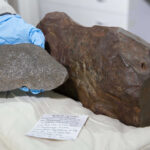A NASA astronaut aboard the International Space Station (ISS) managed to capture an impressive image of a “sprite,” an unusual type of lightning that forms in the Earth’s mesosphere. The photograph, shared on social media, has attracted attention for the beauty and rarity of this atmospheric phenomenon.
The discovery
Flight engineer Nichole Ayers, who is currently on the ISS, posted the image along with an excited message:
Just. Wow. As we fly over Mexico and the United States this morning, I captured this sprite.
Ayers explained that sprites are part of a group of phenomena known as Transient Luminous Events (TLEs), which occur above the clouds and are caused by intense electrical activity in the storms below.
What are sprites and why are they important?
According to the National Oceanic and Atmospheric Administration (NOAA), sprites are rare electrical phenomena that occur at high altitudes, between 50 and 90 km above the Earth’s surface (in the Mesosphere). Unlike traditional lightning, which descends from the clouds, sprites shoot upward, forming reddish or bluish tendrils.
Features:
- • Duration: They usually last only a few seconds.
- • Height: They can extend up to 96 km (60 miles) above the storms.
- • Difficulty studying them: They are difficult to observe from the surface due to their short duration and height.
The importance of photography from space
The ISS offers a privileged view above the clouds, allowing astronauts to capture images like this. According to Ayers, these photographs help scientists:
- • Better understand the formation of TLE.
- • Analyse their characteristics and relationship with thunderstorms.
- • Improve climate and electrical activity models in the upper atmosphere.
The image captured by Nichole Ayers is not only a visual spectacle, but also a valuable contribution to atmospheric science. The sprites remain a mystery in many ways, and observations like this help unravel their secrets.
Did you know that… Sprites are also known as atmospheric goblins and were first photographed in 1989, although pilots had already reported them decades earlier.




